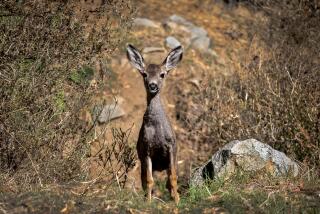Biologists Propose Killing Wild Pigs on Santa Cruz Island
- Share via
In a $7.5-million effort to salvage threatened native plants and animals, biologists are proposing to kill thousands of feral pigs that roam Santa Cruz Island and burn away the fennel plants where they hide.
An estimated 4,000 wild pigs live on the island, and it would take at least six years to eradicate them, biologists said in a report released Tuesday.
Removing the pigs is just one goal in a broader effort to undo the effects of a century of ranching, hunting and other enterprises on the island, the largest in the chain that makes up Channel Islands National Park off Ventura County’s coast.
The plan is part of a process that also includes moving out golden eagles that prey on the pigs, bringing back native bald eagles and studying whether to start a captive breeding program for the threatened island fox.
In addition, the U. S. Fish and Wildlife Service released its recommendations last week for the recovery of 13 endangered plants--with such non-household names as Hoffman’s slender-flowered gilia and Santa Cruz Island bushmallow--on the five Channel Islands that make up the park.
The pigs are big, furry and, for the most part, have their run of the island. They are blamed for rooting up native plants and spreading the seeds of invasive fennel, trampling Chumash artifacts and putting the threatened island fox in further danger.
The project would begin with controlled burns of the nonnative fennel that covers 10% of the island. Besides providing cover for the pigs, the fennel crowds out endangered plant species.
With no place to hide, the pigs would be shot and killed by hunters moving methodically across six territories of about 12,000 acres each.
“They’re eating rare plants and equally rare animals, all the things on the ground that have evolved for millions of years without those predators,” said Gary Davis, senior scientist at the national park. “What we’re doing is trying to fix the island.”
While some may question the cost, botanist Tim Thomas said there is value in saving threatened plants and animals.
“We could be terminating a really valuable resource,” said Thomas, who prepared the Fish and Wildlife report. “The more species we let disappear under our watch, the more fingers we’ll have pointed at us by future generations.”
Animal activists called the plan cruel and unnecessary, even if well-intentioned.
“They were abandoned there and they did the best they can,” said Stephanie Boyles, a wildlife biologist with People for the Ethical Treatment of Animals. “Now we’re killing them because they found a means to survive.”
Boyles suggested trapping the pigs alive and using lethal injection, or using contraceptives to let the pigs gradually diminish. But she admitted that those methods would not work as quickly.
“But they’ve been there for decades now,” she said. “[Scientists are] now in a hurry to establish a semblance of what it used to be like.”
The pigs can’t be brought to the mainland because they may carry diseases, said Tim Coonan, a biologist with the park service.
“Once you accept the fact that they can’t be taken alive, shooting is the most humane way to go,” he said.
A similar eradication plan is under way on Catalina Island. Feral pigs also were removed a decade ago from Santa Rosa Island, which is also in the park. But scientists there were dealing with a much smaller population, about 1,500 pigs, and smaller land mass. The process took five years.
Biologists already have about $500,000 a year set aside, but are seeking more funding. That is partly why scientists chose to stagger the program over six years.
Fennel burning could begin early next year, with pig removal not taking place until 2003, Coonan said.
“If we can do this, it will be one of the most significant restoration actions we could ever implement on the island,” he said.
More to Read
Sign up for Essential California
The most important California stories and recommendations in your inbox every morning.
You may occasionally receive promotional content from the Los Angeles Times.










